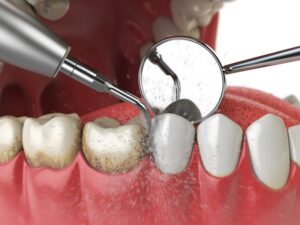
Gum disease is one of the most common oral health problems, and when it progresses beyond the early stages, dentists often recommend a procedure called scaling and root planing. This deep-cleaning treatment is effective at managing periodontal (gum) disease, but many patients understandably have concerns about the cost. If you’re wondering what to expect financially, here’s what you need to know about the expenses of the process.
What is Scaling and Root Planing?
Scaling and root planing is a dental procedure used to treat gum disease by removing plaque, tartar, and bacteria from below the gumline. During the “scaling” part, a hygienist carefully removes hardened deposits from the surfaces of the teeth and beneath the gums. The “root planing” step involves smoothing out the tooth roots to help the gums reattach and to make it more difficult for bacteria to accumulate in the future. This non-surgical treatment is often recommended for patients with early to moderate periodontitis and can help prevent the progression of gum disease and tooth loss.
What Does Scaling and Root Planing Cost?
The national average cost of scaling and root planing per quadrant is $242 but can range from $185 to $444.
The cost of scaling and root planing varies depending on several factors such as location, the severity of the gum disease, and whether you have dental insurance. Here’s a general breakdown:
Without Insurance (Per Quadrant)
- Average cost per quadrant: $150 – $400.
- Full mouth (4 quadrants): $600 – $1,600 total.
With Insurance
- Many dental insurance plans cover 50 – 80 percent of the cost.
- Your out-of-pocket cost could be as low as $75–$200 per quadrant depending on your coverage.
Is the Procedure Covered by Insurance?
Many dental insurance plans cover scaling and root planing, especially if it’s deemed medically necessary for gum disease. Coverage can vary, but it’s common for plans to provide for at least a portion of the cost, often around 50 percent. To know for sure, it’s best to review your insurance policy or call your provider directly and ask if they will pay for the treatment.
How Do I Prevent the Need for Scaling and Root Planing?
This starts with maintaining excellent daily oral hygiene and committing to regular dental visits. Brushing for two minutes twice a day, flossing daily to remove plaque between the teeth, and using an antibacterial mouthwash can significantly reduce the buildup of plaque and tartar that lead to gum disease.
Regular professional cleanings, typically every six months, allow your dentist to catch early signs of gum inflammation before it progresses. A balanced diet low in sugar and high in fruits, vegetables, and lean meats also supports gum health. By staying proactive and consistent with oral care, most people can avoid the deep cleaning process.
Try to steer clear of scaling and root planing by doing your part with an effective oral hygiene routine and balanced diet. However, if you do require the treatment, check with your insurance company beforehand to understand the exact costs you’re responsible for before forking over your hard-earned money. A more convenient option may be to contact the treatment coordinator at your dentist’s office who can give you a cost estimate before a procedure, which includes insurance coverage.
About the Author
Dr. Barry Miller is a graduate of The Ohio State University with considerable hours spent continuing his education, especially in the surgical aspects of dentistry. Dr. Miller and our team at Northwest Family Dental of Marysville can treat your gum disease issues with a two-pronged approach of antibiotics and scaling and root planing. Schedule your appointment today through our website or call our office at (937) 642-3434.
